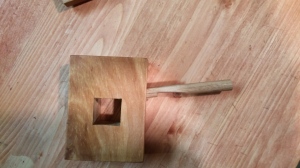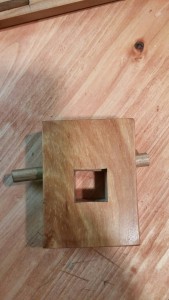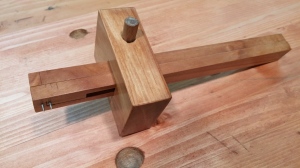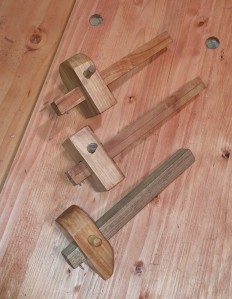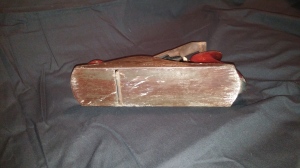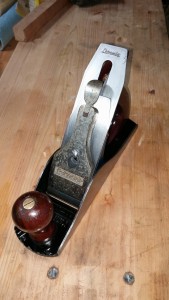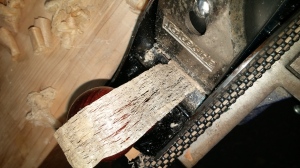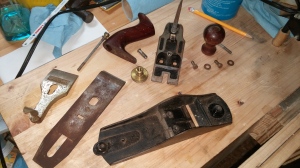Tags
I’ve been making do with this combination marking and mortise gauge from Harbor Freight www.harborfreight.com/6-inch-mortise-gauge-94645.html.
The mortise gauge side is useless, as it has a broken pin that can’t be corrected. I moved the pin on the single pin side from the bottom of the arm to the corner to increase its functionality (Another tip from Paul Sellers from this post: https://paulsellers.com/2011/10/make-your-own-5061-style-gauge/). This improved the gauge a lot, but it didn’t take long for it to wear enough for the fence to beam tolerance to wear enough to make the gauge frustrating to use. The thumbscrew is difficult to tighten, and the gauge takes both hands to adjust. I suppose for the 10 bucks or so I spent on it I can’t complain, but once I understood how the tool was supposed to work, I wanted something better.
I inherited a Stanley Dual beam marking gauge and a really nice screw adjustable mortise gauge from my grandfather, but both of them need new pins and I bought the wrong size music wire to replace them. They’ll also be going to my father as part of his retirement present after I restore them, so I knew I would need my own. I did quite a bit of looking around the internet at different designs. Most of the good ones around are based on an old French design recently brought back to life in an article by Dean Jansa in Popular Woodworking Magazine (You can download the article here: www.popularwoodworking.com/articleindex/mystery_of_the_marking_gauge). They work by using a wedge or a dowel mortised at an angle to the beam.
I first saw this design in this video on the Logan Cabinet Shoppe a couple of years ago but didn’t think much of it at the time.
I found it again on the Literary Workshop blog not too long ago (literaryworkshop.wordpress.com/2012/06/22/how-to-make-a-marking-gauge/) along with a design for a really neat design for a mortise gauge (literaryworkshop.wordpress.com/2011/09/08/a-mortise-gauge-you-can-make/) I was really impressed with the mortise gauge, but wasn’t sure I would like the dowel locking mechanism, thinking it would be annoying to lock and unlock. I decided to try it, so I made a couple of the marking gauges since they would be pretty quick to make. I decided to make them with only hand tools, so it took a few hours, but I really enjoyed it.
I used Apple wood for the fences, and made one of the beams from the same Apple board and the other from Walnut. I also beveled the bottom corner on one. I considered using the same wood and pattern for both of them, but thought it would be nice to be able to tell them apart at a glance if I was using them both on a project for different settings. I finished them with shellac and a coat of furniture wax. You can see how the locking mechanism works, you can click the pictures to enlarge them if you need to:
Loose position:
Locked position:
Then it was time for a test drive.
I am seriously impressed with these gauges. They are easily set with one hand, pressing on the dowel with my thumb holds the setting temporarily so I can check it with a ruler or against the piece to be marked. A quick tap of the dowel on the bench locks it solidly. Another bench tap on the other side of the dowel releases everything nicely.
Once I decided I liked the locking mechanism, it was time to build the mortise gauge. This was a bit more of a complicated build, with a small through mortise and sliding block in the beams that have to fit very closely, as well as two beams that have to fit the fence mortise perfectly instead of just one. It came out ok, but the next one I build will be better. I did all the steps correctly, but I will do them in a different order next time to make things simpler and a little neater.
I used Apple again, because I love the way it looks and it works really nicely. When I was touching up the pins with a diamond card file before I rounded the top of the fence I realized that being able to set it upside down on a flat top was pretty convenient for this operation. I also thought that keeping the mortise gauge square would make it easy to tell it apart from my other gauges in the bottom of a dark drawer or on the bench, so I skipped the round top.
The cut lines on the beams correspond to the widths of the three chisels I use the most for mortising, a 1/4″, 3/8″, and a 1/2″, but the pins can be set from 3/16″ to up to 1″ apart.
Here it is taken apart:
And all of them together:
I really enjoyed these builds, and they were a nice refresher for some hand tool skills I haven’t used in a while. I hope they don’t wear the way that my Harbor Freight gauge has, but if they only last a few years they aren’t hard to make. I’ll definitely be making a set like this for Dad’s tool kit, maybe out of some figured wood.



